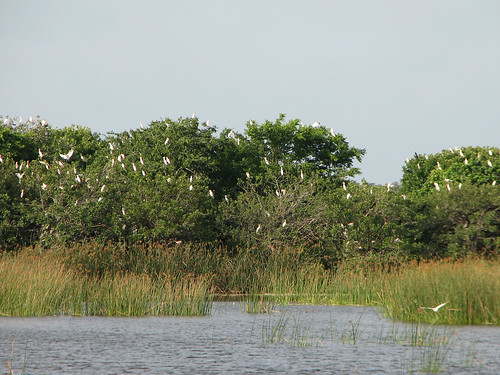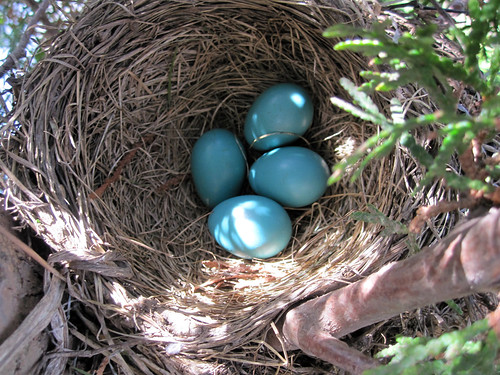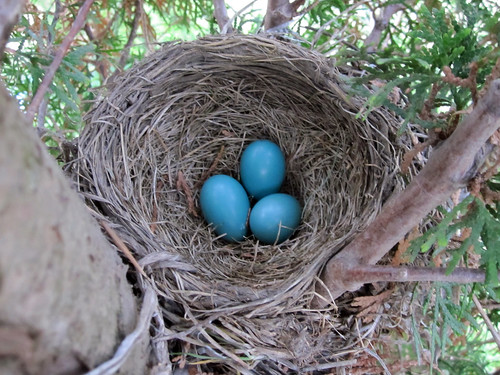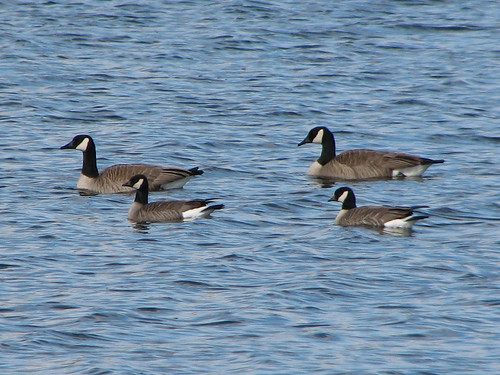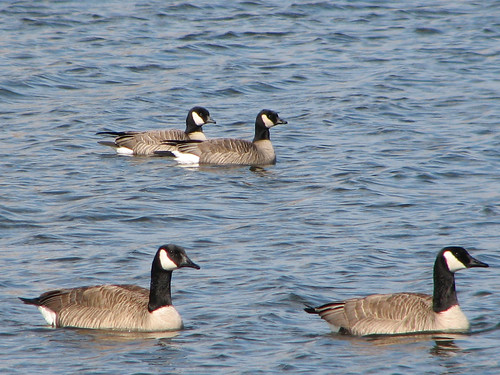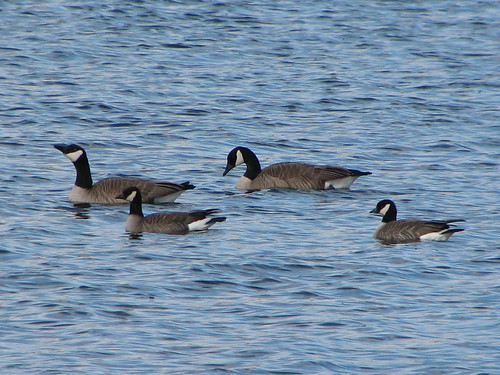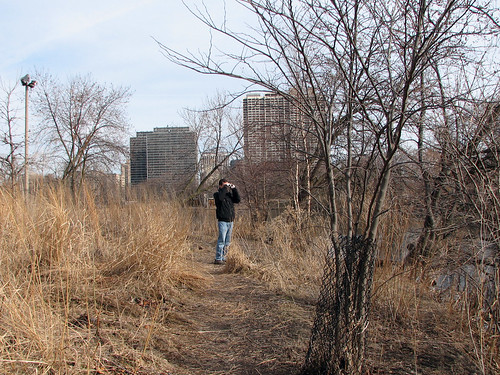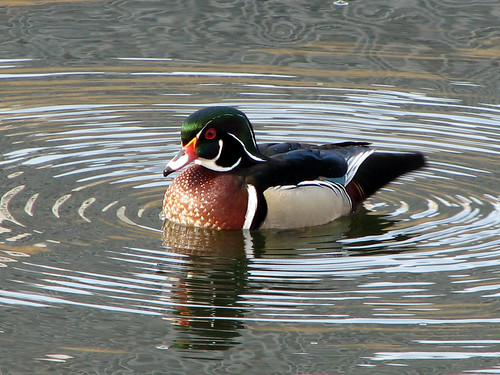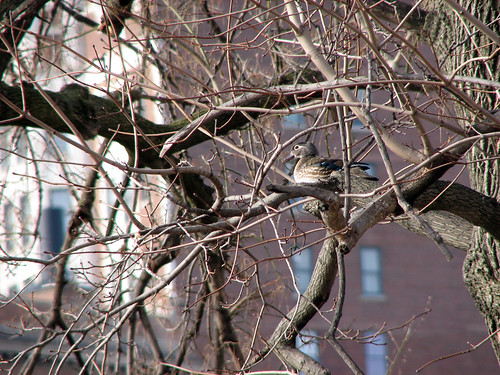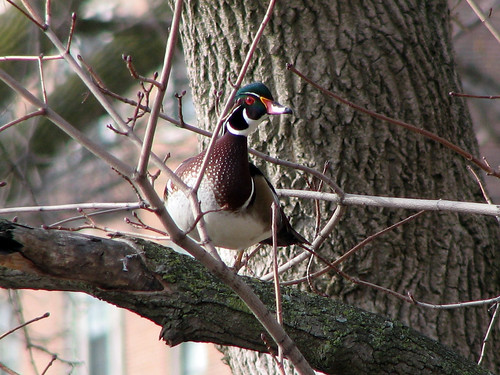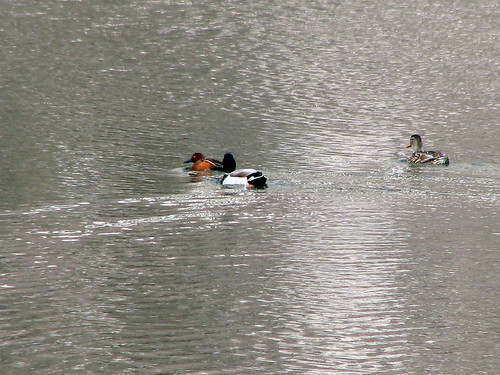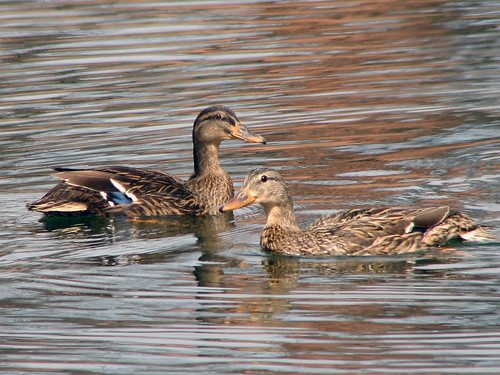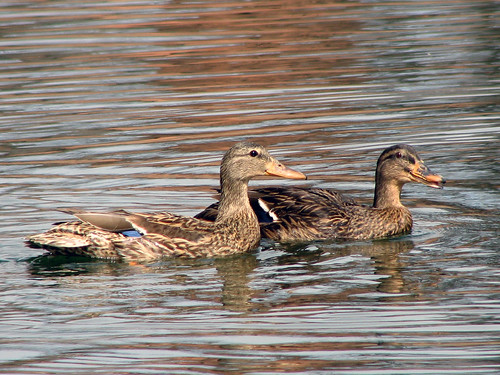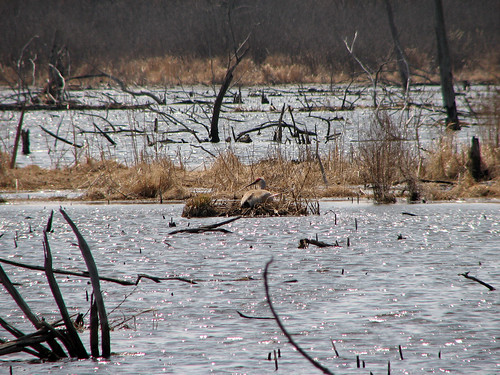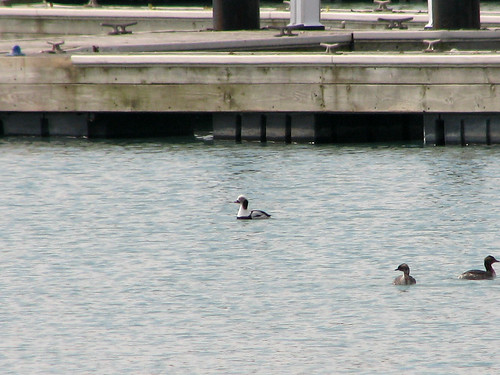Gearing up to move from Chicagoland to central Florida in mid-June might seem like a case of reverse migration, but that’s exactly what we’re planning on doing in just under three weeks. I’m looking forward to this new adventure but I’m also terribly sad to leave behind so many good friends and my family. Between the packing and the planning, stay tuned for more news on our big move.
Robin nest redux
We have nesting American Robins in our front arborvitae again this spring. Last year the nest was constructed from scratch; two babies fledged. Here’s a picture from last year which shows the location of the nest.
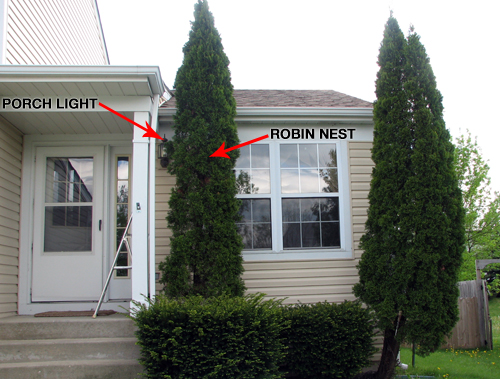
This year, I first noticed activity in the nest on April 20th, when the female robin was making frequent visits to the nest. She was bringing in soft grasses and mud to reline the existing nest, which was in good shape. I looked inside the nest on April 22nd; it was empty. We were away from April 23rd to May 1st, so the next time I could check the nest was on May 2nd, when I found four eggs.
According to the Birds of North America Online, American Robins lay one egg per day. The incubation period from the date of the last egg being laid varies from 12 to 14 days. The fourth egg could have been laid any time between April 26th and May 1st. Therefore the window I’d expect the eggs to hatch would be from May 8th to May 14th.
Yesterday, I didn’t notice any increased activity at the nest site. The female was seen on the eggs more often than not, but in the early afternoon when I had a peek from our living room I saw the female was away. I took her break time as a quick chance to peek inside the nest. I was very surprised at what I found.
I am very curious about what happened to the fourth egg. There is no trace of it underneath the nest or in the branches below the nest. American Robins are known to have the ability to recognize a Brown-headed Cowbird (a brood parasite species) egg when it is laid in their nest. The robin will puncture the intruding egg and remove it. I wonder if the nest was used by a cowbird and one of the robin eggs was accidentally lost when the cowbird egg was removed? It’s also possible an egg was predated by a crow. I guess I’ll never know. So now, like last year, we are waiting for three eggs to hatch.
Again this year I’m entering the nest data in the online citizen scientist database at Cornell’s Nestwatch. If you’ve got nesting birds on your property, consider observing the activity and entering your findings in the Nestwatch database. It’s free, fun, and educational, and it helps ornithologists (and the birds) too!
BPW: Cackling Goose
The Cackling Goose is a newly-recognized full species. Formerly it was considered a small subspecies of the Canada Goose. The plumage of the Canada Goose and Cackling Goose are very similar. Cackling Geese have have an overall smaller body size. Common Canada Geese average a 60″ wingspan and weigh around 9.8 lbs; Cackling Geese have a wingspan averaging 43″ and weigh just around 3.5 lbs. The bill of the Cackling Goose is also proportionally smaller compared with the head, which is more round in shape.
Besides the physical differences, the breeding range of the Cackling Goose is further north and west than the Canada Goose.
In late March, during a Loon-finding trip with Lake-Cook Audubon, I had my most recent Cackling Goose sighting at the Prairie Crossing subdivision. Cackling Geese pass through the area regularly during migration, so I was surprised when my entry into eBird triggered a question from a volunteer regional reviewer. Good thing I had pictures. 
The Cackling Geese were very cooperative, hanging out with larger Canada Geese for easy identification and comparison. The water at Prairie Crossing was full of cute waterfowl that afternoon, also hosting Bufflehead, Ruddy Duck and Pied-billed Grebe.
Learn more about Cackling Geese by reading David Sibley’s Distinguishing Cackling and Canada Goose and All About Birds’ Cackling Goose.
Bird Photography Weekly is a regular collection of user-submitted bird photos from all over the world. The new edition comes out every Sunday. Go have a look at this week’s submissions!

Allopreening Mourning Doves
Back in February, during a light snow, I noticed a few Mourning Doves loafing on the shelter frame on our back patio. Two of them must have been in the mood for love because they started allopreening – pecking and grooming each other about the head and neck. Allopreening is one of my favorite bird behaviors to observe. The last time I got to watch birds do this was back in September 2010 when I watched a pair of Eurasian Spoonbills going to town.
According to the Mourning Dove species account at the Birds of North America Online,
Allopreening, a form of appeasement behavior, occurs between mates during pair formation and consists of gentle nibbling of feathers in head and neck regions with beak; seen during nest-site selection activities, nest-building, prior to copulation, and occasionally during nest exchanges. Displacement, or ritual preening, may be exhibited when close to a mate.
I think some displacement may be going on here as well, but I didn’t see any copulation (bummer, haha!). In the second half of the clip, the bird on the left flutters its wing, a behavior I would normally associate with food-begging in either courting females or hungry juveniles. Although the birds were not feeding, I wonder if this is another common courtship behavior? From the wing-fluttering and the grooming behavior of both I am guessing the male is on the right and the female on the left.
Looking further at the Mourning Dove account on BNA, I learned two interesting terms associated with their courtship behavior. First is the charge, in which the male approaches the female with head held horizontally forward, tail pointed horizontally back, and whole body raised. And then there’s the totally cute term bow coo (which I keep reading as “boo cow”), in which the male bows head and body until head nearly touches ground [≤ 10 times], rises to very erect position, holds head forward, and utters loud coo. Have you seen these behaviors in Mourning Doves before? How about allopreening?
North Pond: Wood Ducks & a lifer
Following our rescue & recovery route one Thursday morning in late March, Arthur and I headed to a Chicago birding hotspot, North Pond in Lincoln Park.
We were hoping to see a Cinnamon Teal, a bird that had first been spotted at the pond on March 11th — almost three weeks prior to our visit. There hadn’t been any reports of the bird in recent days, so I fully expected it might already be gone.
We didn’t have a huge amount of time, so we walked the path around the pond, concentrating on the ducks and looking for the Cinnamon Teal. Most of the birds we saw were Wood Ducks and Mallards.
There were Wood Ducks all over the place, making their darling squeaky call and acting much less afraid than most of the Wood Ducks we encounter outside of the city.
We even got to see some Wood Ducks in their other element, perched above us on tree limbs.
As we were finishing our walk around the pond, I was making a sad face, for we had not see the Cinnamon Teal. Just as we were about to leave, we looked back for one more check of the water, and finally saw our prize.
My visitors came from *where* in April 2011?!?!?
Here are some of the more interesting search terms that brought visitors to this site during April 2011. This is part of an ongoing monthly series on blog search terms.
Falling under the oddly specific category were the following searches:gray jay with wet disheveled feathers; owl at the beleef de lente site is in her box – wait now may be leaving; and bald eagles stealing groceries in alaska.
Typos of the month were pictures of flying cardnil, magnifocent frigatebird.com, and eagles live webcam illisnio.
Filed under let’s not go there: cats as bomb guidance; birds have a penis (yes, some do!); twitching tits; and are birders weird (of course — there are weirdos all over, amiright?).
The fortune teller prize goes to the person that came to this site via this search: birding blogs florida. Stay tuned!
Finally, I hope the person who searched for falcon snatching prey early in the month had a chance to see this amazing clip from Massachusetts which was posted to YouTube on April 27th. It shows a Peregrine Falcon taking a white-faced ibis (a rare bird for the state) as prey.
Three releases & a lifer
In late March Arthur and I were asked to release three birds after rehab with Flint Creek Wildlife Rehabilitation. A Cooper’s Hawk that was hit by a car in Chicago needed to be released close to where she was first recovered, and a pair of Mallards were to be released at a site Long Grove.
We picked up the birds at the FCWR Itasca facility in the morning, and placed the carefully labeled boxes in the back of our car. First we released the Cooper’s Hawk. With these birds, I learned that you typically just have to open the carrier and they’re gone in a flash. This big girl was no exception.
Next we traveled to Long Grove to release the two Mallards. These were both eager to be on their way, too, although once they were in the water they seemed a lot more relaxed.
It took us a few moments to release the second duck after the first, but as soon as we did, the first duck swam right over to join his friend.
With the birds released, we found we had some time to spare before our next appointment. We checked the Illinois birding listserv, IBET, using our iPhone. We learned that a Surf Scoter, first reported the day before, had been refound earlier in the afternoon in Mundelein. That wasn’t too much of a detour between Long Grove and our next destination so we headed over to St. Mary’s Lake in search of the scoter. We found the bird and had some nice looks (despite the lousy photo below). The Surf Scoter was a life bird for both of us.
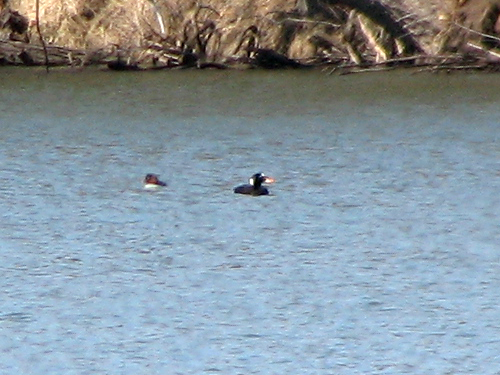
This was a couple of weeks after we released a pair of birds at Burnham Harbor and found our lifer Long-tailed Duck at the same time. I wonder what we’ll find next time we release rehabbed birds?!
Flint Creek Wildlife Rehabilitation is a non-profit, federally licensed rehab organization with locations in Chicago, Itasca and Barrington, Illinois. You can follow their blog here, follow them on Facebook here, and make donations online here.
A little R&R at H&H
In mid-March Arthur and I joined our bird club, Lake-Cook Audubon, on a waterfowl weekend trip down to DeKalb, La Salle and Putnam counties in north-central Illinois. In the weeks prior to the trip we had been feeling overworked and stressed out about some personal issues, so a weekend of birding was just what the doctor ordered.
The weather was seasonably cool with clear skies on Saturday and intermittent rain on Sunday. Overall it was a really nice weekend where we picked up 16 year birds, including American White Pelican flying over Buffalo Rock State Park, Barred Owl (heard only) at Matthiessen State Park, and Pileated Woodpeckers in Putnam County. We also picked up three lifers for the trip, although I’m pretty sure we’d seen Canvasback and Eurasian Tree Sparrow before. The other lifer was Ross’s Goose.
Our itinerary included a lot of area birding hotspots we’d heard of before but never previously had the chance to visit, including Shabbona Lake State Park and Hennepin and Hopper, our main destination on Sunday.
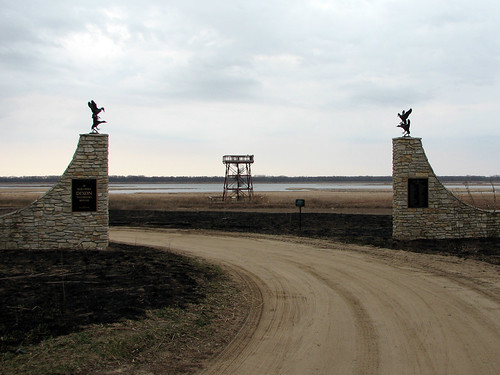
The entrance to the Dixon Waterfowl Refuge
Hennepin and Hopper are two backwater lakes of the Illinois River. In the 1800s the area was known as an outdoorsman’s paradise, with legendary prosperity in both hunting and fishing. However, in the late 1800s the land was developed with levees and ditches. A pumping station lifted the water into the river and the land was claimed for agriculture. By 2000 the land was owned by eight private landowners. The Wetlands Initiative (TWI) transferred the lands of the Hennepin Drainage and Levee District to a private nonprofit organization. TWI moved to restore the hydrology of the land to its original condition. After just one season of work, flora and fauna that had been absent from the area since it was first developed began to recolonize the site. In 2005 the site was dedicated as the Dixon Waterfowl Refuge. The site faced another challenge in the late 2000s, when huge numbers of common carp infested the lakes. In 2008, waterfowl numbers were down 90% compared to the peak season of 2004. In 2009 the water was drained in order to remove the carp. Water levels were restored, the lakes were stocked with native fish, and the waterfowl and other native fauna has returned.
A large viewing platform looks over the lakes. Our group climbed to the top and looked over the water through our scopes.
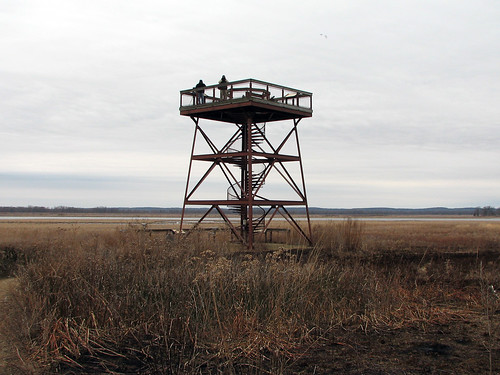
This impressive viewing platform gives birders a great view over the lakes and wetlands
Waterfowl on the lakes included Wood Duck, Gadwall, Northern Shoveler, Northern Pintail, Canvasback, Ring-necked Duck, and Bufflehead.
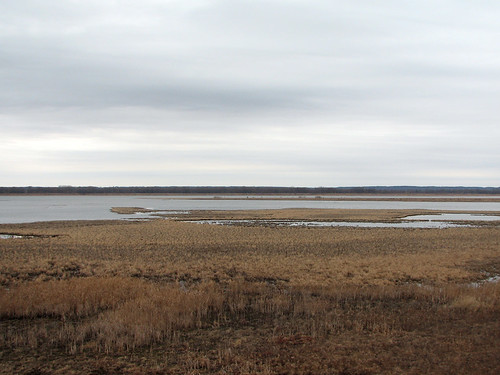
Hennepin and Hopper on a drizzly March day
After checking out the water from the main viewing platform we walked out to another vantage point along the lakes. Normally we might have chosen to drive out, especially since it was threatening rain, but a truck got stuck in the muddy road and made it impossible for any other cars to pass.
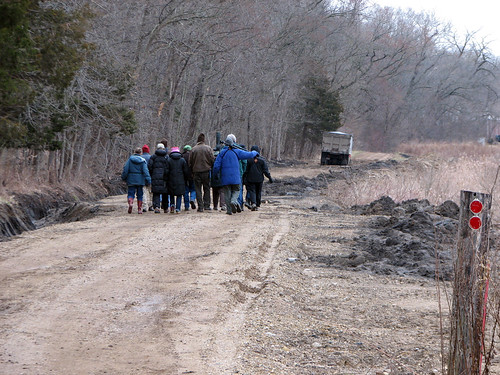
Birders walking to another vantage point
We had a great visit at Hennepin and Hopper, the headline location for the weekend birding trip. I’m looking forward to visiting again. From the site stewards we learned that the marshes usually attract a fair number of nesting Yellow-headed Blackbirds – an extra reason to return!
Wordless Wednesday: Sandhill Nest
When not to get a flat tire
Last month Arthur and I were asked to release a couple of birds after they were rehabbed by Flint Creek Wildlife Rehabilitation. It was a lovely Sunday morning when we drove out to the northwest suburbs to pick up the birds, a Lesser Scaup and an American Coot. We packed up the carriers and headed to the release site, Burnham Harbor in Chicago. The ride was uneventful until a couple of drivers in neighboring cars on the Kennedy indicated to us that we had a flat tire. We pulled off at the closest service station and were shocked to find the rear passenger tire completely flat. How could we not have felt that?! To avoid disturbing the birds too much, we elected to try filling up the tire and see if it would hold, rather than tearing up the back of our minivan in order to get the spare and tools out. Luckily the tire held… for the next ten minutes or so. Again we limped into a service station and filled the tire. We ended up stopping once more before finally rolling into Burnham Harbor with our fowl friends none the wiser.
The coot in particular was raring to go and was off flying as soon as I opened the carrier. Unfortunately we were a bit flabbergasted at the coot’s sudden departure; we aimed to document the release but only managed this photo immediately prior to the coot’s strong flight the hell away from us.
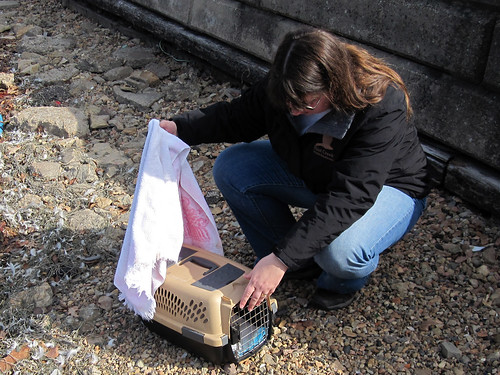
There’s a coot in there, really!
The scaup release was a bit more typical. I opened the carrier and the duck retreated to the back of the container. I gently lifted him out and placed him before the water. After a booty shake he was happily paddling in the water, not in any particular hurry at all but apparently delighted to be swimming free once again.
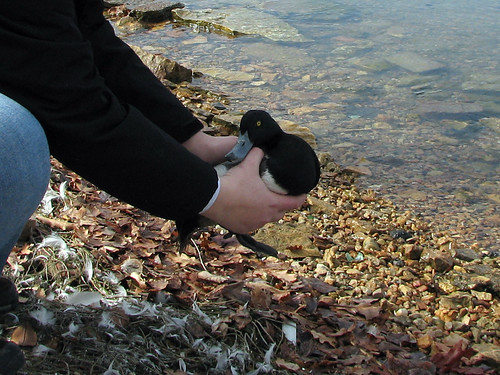
Moving the scaup from the carrier to freedom
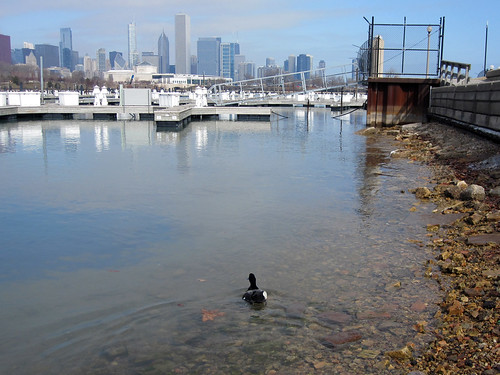
Lesser Scaup shortly after release
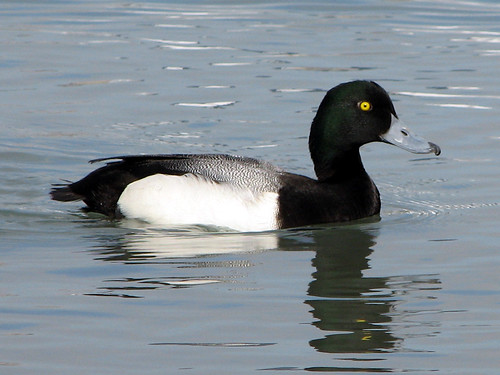
Handsome, healthy Lesser Scaup just after release
With the birds safely released, the next order of business was changing the flat.
This went off without a hitch, more or less, and with that out of the way we decided to see who else was out on the water. A Long-tailed Duck had been seen in Burnham Harbor, on and off, for several days prior to our visit. We found some other birders who let us know a female Long-tailed Duck was on the north side of the harbor. We couldn’t relocate her and decided to go back to the car to get the scope and check the birds on the south side. There we found lots of ducks, including Redhead, Common Goldeneye, lots of Lesser Scaup (some of which greeted our old charge shortly after his release), mergansers, plus this handsome fellow:
There was also a group of eight Horned Grebe, which was the most I’d ever seen at once.

Six of the eight Horned Grebes
Despite the flat tire it was a great morning out and we were thrilled to be able to release the rehabbed birds and score a lifer at the same time. Believe it or not, the next time we released birds for Flint Creek we were able to find another life bird on the same trip! Stay tuned for that story…
Flint Creek Wildlife Rehabilitation is a non-profit, federally licensed rehab organization with locations in Chicago, Itasca and Barrington, Illinois. You can follow their blog here, follow them on Facebook here, and make donations online here.

